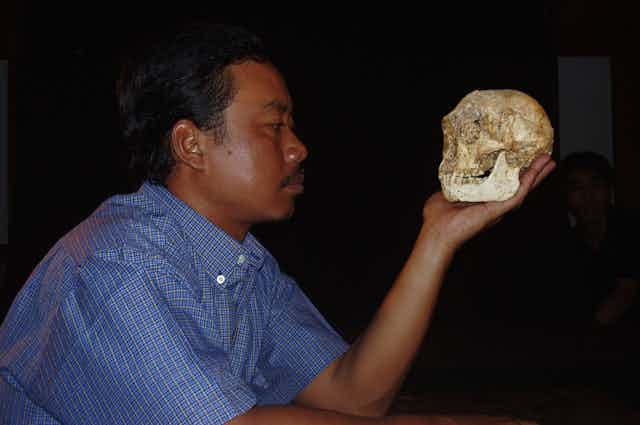Ten years ago today in Australia and Indonesia the scientific world was turned on its head. By a very small head, as it happens. We were part of the original joint Australian-Indonesian research team involved in the discovery of human remains, unlike anything seen before, that was announced in the pages of the journal Nature – and broadcast around the world by a frenzied media.
The newly reported species of human – Homo floresiensis – seemed to have survived until just 18,000 years ago on Flores, a far-flung island in eastern Indonesia. At only a metre tall, with the brain the size of a chimp’s and a host of anatomical features that harked back to a much earlier period in human evolution, it made no sense whatsoever.
Some thought the new find – dubbed “Hobbit” by the indefatigable leader of the Australian team, Mike Morwood – might be a hoax, the Asian equivalent of Piltdown Man.
Others thought the unusual mix of features was the unfortunate consequence of one of our species (Homo sapiens) suffering from a severe medical condition called microcephaly, in which the head and brain are massively reduced in size.
Fast forward to 2014. What lessons have we learned after ten more years of research at Liang Bua, the limestone cave in which the Hobbit was discovered? And what don’t we yet know about this diminutive species of human?
As part of the ongoing Australian-Indonesian research team at Liang Bua, we offer a personal reflection on the past decade of Hobbit adventures and sneak a peek at the next chapter of exploration.
Building a body of evidence
We got lucky in September 2003. Bones are rarely preserved as fossils, so we hit pay dirt when the partial skeleton of LB1 – the abbreviation for Liang Bua 1, the type specimen of Homo floresiensis – was uncovered at the bottom of a six-metre pit dug by archaeologists from the National Centre for Archaeology in Jakarta.

We’d been searching for the remains of the ancestors of the first Australians: early Homo sapiens dispersing through the Indonesian archipelago to Australia. But it soon became clear that this was a different creature entirely.
The skull was that of an adult human but far too small to be one of our species, and many other features of the skull, teeth and mandible (lower jaw) didn’t fit the modern human mould.
The same was also true of the rest of the body, with the Hobbit having very different limb proportions to us. Some other researchers begged to differ and have continued to do over the past decade, proposing a variety of different pathologies, such as Down syndrome, to explain the curious anatomy of the Hobbit.
But as more bones have been excavated and described, the “sick Hobbit hypothesis” – a term coined by American palaeoanthropologist Bill Jungers – has proved inadequate to explain the full package of Hobbit features.
The wrist bones, for example, have a primitive morphology akin to those of African apes and unlike those of modern humans, with or without a growth disorder. Expert opinion currently supports overwhelmingly the original diagnosis of the Hobbit as a new species, with the remains of at least six individuals now known from Liang Bua.
A window into the past
Where are the biggest gaps in our knowledge of the Hobbit, and what are the burning questions? There are many of both.
Two gaping holes are the early years of the Hobbit – including its evolutionary backstory and route of passage to Flores – and its final days. When did the ancestors of the Hobbit first arrive on the island, and when and why did the last survivors perish?
Their extinction might be connected with the migration of early modern humans through Indonesia, but we have no evidence of any contact between the two species at the present time.
It’s even possible that Hobbits bumped into, and bred with, the enigmatic Denisovans – a sister group to Neanderthals – who may have inhabited parts of Southeast Asia at the same time as Hobbits and Homo sapiens.

The stark reality is that Liang Bua – pictured above – will not contain the entire record of evolution and extinction of Hobbits. The cave deposits represent a snapshot in time, a glimpse of human activities over the past 100,000 years. But we remain ignorant of the early evolutionary development of the Hobbit.
Did the Hobbit evolve from a small-bodied emigrant from Africa, perhaps an australopithecine or an early member of our genus, such as Homo habilis, possessed with wanderlust?
Or did it derive from a larger-bodied form, possibly a group of Homo erectus island-hopping across from the nearby island of Java, which then dwarfed to Hobbit-size after reaching Flores? We need more Hobbit bones from more sites, spread over a wider geographic and time range, to answer such questions.
Happy anniversary, Hobbit!
The past ten years have been exhilarating for us, but how can we best solve these prehistoric puzzles? To commemorate the Hobbit anniversary, the University of Wollongong has this week announced the Michael J Morwood Fellowship, named in memory of Mike Morwood, who died last year.

With the award of the inaugural postdoctoral fellowship to one of us (Thomas Sutikna), we intend to build on Mike’s vision of archaeological exploration in Indonesia.
Excavations at Liang Bua will be enlarged in the quest for additional Hobbit fossils for new scientific analyses, and clues to their evolutionary history and former range will be sought elsewhere on Flores and other Indonesian islands.
An enduring lesson from ten years ago is that we should expect the unexpected when excavating the “Lost Worlds” of Indonesia. It is not beyond reason to think that another new species of human might be discovered in the years ahead, and a new companion welcomed into the palaeoanthropological Fellowship of the Ring.

